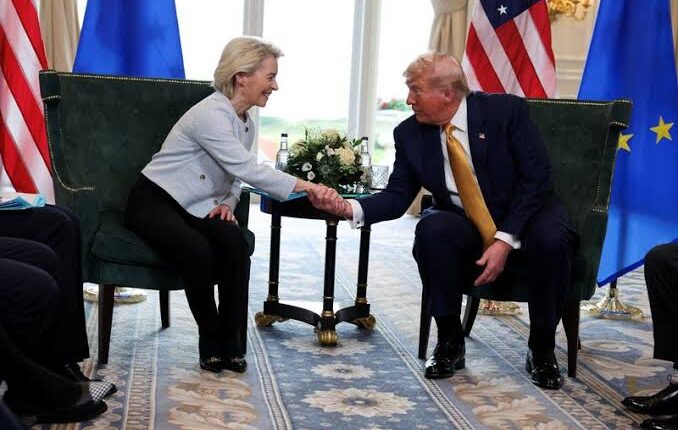US, EU Reach Landmark Deal on 15% Tariff to Avert Trade War
The United States and the European Union have struck a major trade agreement that imposes a 15% import tariff on most EU goods, averting a wider transatlantic trade war and reshaping global economic ties.
The deal was finalized Sunday after a high-level meeting between U.S. President Donald Trump and European Commission President Ursula von der Leyen at Trump’s golf resort in Turnberry, Scotland. The agreement cuts in half the previously threatened 30% tariff and follows months of tense negotiations.
“This is the biggest deal ever made,” Trump declared, highlighting EU commitments to invest over $600 billion in the U.S. and significantly increase purchases of American energy and military equipment.
Von der Leyen, who called Trump a “tough negotiator,” described the 15% rate as “the best we could get,” noting the pact brings much-needed stability and predictability between the world’s two largest economies.
The deal mirrors elements of last week’s $550 billion U.S.-Japan trade framework, but still leaves critical details unresolved—such as tariffs on spirits and standards for non-tariff barriers in sectors like autos and agriculture.
According to Trump, the agreement includes $750 billion worth of EU commitments to buy U.S. energy and “hundreds of billions” in arms purchases. The deal could benefit major European companies like Airbus, Mercedes-Benz, and Novo Nordisk—provided that all provisions are honored.
German Chancellor Friedrich Merz welcomed the agreement, saying it spared Germany’s export-heavy economy from a damaging trade dispute. European automakers, including Volkswagen, BMW, and Mercedes, have faced stiff 27.5% tariffs on U.S. car and parts imports, and had been bracing for further hikes.
Still, the 15% base tariff has drawn criticism in Europe. Many EU officials had pushed for a zero-for-zero deal, and there are concerns the new EU investments in the U.S. could strain budgets at home.
Trump retains the authority to raise tariffs if the EU fails to meet its investment commitments, a senior U.S. official confirmed.
Markets responded modestly to the news, with the euro rising 0.2% against the dollar, pound, and yen within an hour of the announcement.
While key sectors like aircraft, semiconductor tools, certain chemicals, and some agricultural products were exempted from tariffs, the U.S. will maintain a 50% duty on steel and aluminum—though discussions on a quota system are ongoing.
“This is a high-level political agreement,” said Carsten Nickel of Teneo Research. “Without detailed terms, there’s a risk of conflicting interpretations, as seen with the U.S.-Japan deal.”
The pact is expected to bolster Trump’s trade agenda as he continues efforts to reduce longstanding U.S. trade deficits. He has already reached similar framework agreements with Britain, Japan, Indonesia, and Vietnam—though his goal of “90 deals in 90 days” remains unmet.
Trump has long criticized the EU, accusing it of exploiting the U.S. on trade. In 2024 alone, the U.S. merchandise trade deficit with the EU hit $235 billion.
With both sides hailing the new deal as a breakthrough, the focus now shifts to ironing out the details—and avoiding future flashpoints.



[…] Livestock Department are providing temporary shelters in several border provinces to care for animals left behind during the […]